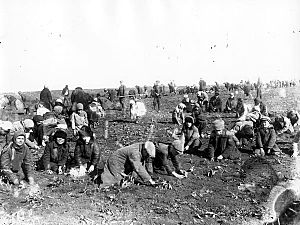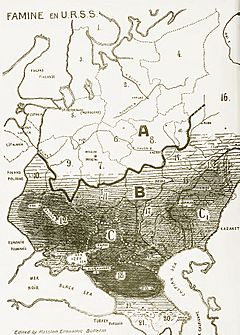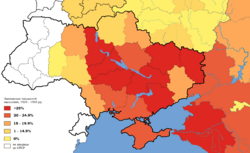Holodomor facts for kids
The Holodomor (Ukrainian: Голодомор) means "murder by hunger" in Ukrainian. It was a terrible, man-made famine that happened in Ukraine in 1932 and 1933. At that time, Ukraine was part of the Soviet Union. About seven million people died from starvation during the Holodomor.
Joseph Stalin was the powerful leader of the Soviet Union, which was a communist country. He forced farmers to change how they worked. He wanted them to work harder for farms owned by the government, often for less money. Many people in Ukraine did not agree with these changes.
When a famine hit Ukraine, Stalin refused to help. Instead, the government took food away from people. It even became against the law to pick up food from the ground in fields. The government also stopped people from moving around to find food.
Some experts and politicians believe the Holodomor was a genocide. They say the Soviet government's actions were a planned attack on Ukrainian people and their desire for independence. They compare the huge loss of life to the Holocaust.
Other experts believe the Holodomor was not planned. They think it was an unexpected and terrible result of Stalin's fast changes to the country's economy and farming. These changes caused big problems for farmers and the country.
Contents
What Does Holodomor Mean?
The word Holodomor comes from the Ukrainian language. It literally means "death by hunger." The full Ukrainian phrase means "to cause death by hunger."
This word was first used in print by Ukrainians living outside the Soviet Union in the 1930s. Inside the Soviet Union, talking about the famine was forbidden. The government called it "anti-Soviet propaganda." It was not until the late 1980s, when old documents were made public, that the truth about the famine could no longer be denied.
Talking about the Holodomor became possible because of a new policy called glasnost, which meant "openness." In Ukraine, the word "famine" was first officially used in 1987. The term Holodomor itself may have first appeared in Soviet newspapers in 1988. Today, Holodomor is in Ukrainian dictionaries. It is described as "artificial hunger, organized on a vast scale by a criminal government against a country's population."
Some historians have even called the Holodomor a "Ukrainian Holocaust."
When and Where Did the Famine Happen?
The famine mainly affected Ukraine and a part of it called the Moldavian Autonomous Soviet Socialist Republic. It started in the spring of 1932 and lasted until July 1933. Most people died in the spring of 1933.
The effects of the famine can be seen in how the population changed. Between 1926 and 1939, Ukraine's population grew by only 6.6%. In comparison, Russia's population grew by 16.9% and Belarus's by 11.7%.
In 1932, the Soviet government collected much less grain than in 1931. This meant there was less food for everyone. Food rations in cities were cut, and many city dwellers also began to starve by spring 1933.
Why Did the Holodomor Happen?
The exact reasons for the famine are still debated. Some experts believe it was caused by both human actions and natural problems. The biggest human cause was the economic issues from Stalin's plan to quickly industrialize the Soviet Union.
Others believe it was a planned attack by Stalin's government to destroy Ukrainians. Historian Stephen G. Wheatcroft says that the grain harvest in the Soviet Union before the famine was very low. This was likely due to bad weather and poor farming tools. However, official reports wrongly claimed a much higher harvest.
The idea that the famine was caused by forced farming and high demands for grain is sometimes questioned. This is because the areas in Ukraine with the most deaths, like Kyiv and Kharkiv, produced less grain than other parts of the country.
In Ukraine, the government forced farmers to join collective farms. This caused a huge crisis and contributed to the famine. From 1929 to 1930, peasants were made to give their land and animals to state-owned farms. They then had to work on these farms for very little pay. This forced collectivization was not popular, and it led to many farmer protests.
Stalin's first five-year plan also changed what Ukrainian farms were expected to grow. They had to grow new crops like sugar beets and cotton instead of their usual grain. Also, the plan was poorly managed. A lot of grain was not harvested, and much of what was harvested was lost during transport or storage.
In 1930, the government started taking food from farms. They said it was to export more grain. Stealing food became a crime punishable by death or 10 years in prison. Even during the famine, the Soviet Union continued to export food, though less than before. Michael Ellman notes that 1.8 million tons of grain were exported in 1932–1933. This amount could have fed 5 million people for a year.
Under the collectivization policy, farmers lost their property. Many were even sent away to Siberia, where they had no way to survive.
How Many People Died?
The Soviet Union denied for a long time that the famine had happened. Government agencies controlled all the records from that time and released them very slowly. Because of this, the exact number of victims is still unknown. It is probably impossible to know the precise number, even within a hundred thousand.
At a meeting in Ukraine in 2016, it was stated that 7 million Ukrainians died during the Holodomor. In total, 10 million people died of starvation across the entire Soviet Union.
| Countries that Officially Recognize the Holodomor as Genocide | ||
|---|---|---|
|
|
||
Images for kids
-
"Light the candle" event at a Holodomor memorial in Kiev, Ukraine
-
Memorial at the Andrushivka village cemetery, Vinnytsia Oblast, Ukraine
-
Memorial in Poltava Oblast, Ukraine
-
Memorial cross in Dnipropetrovsk, Ukraine
-
Viktor Yanukovych and Dmitry Medvedev at the Memorial to the Holodomor Victims in Kiev, Ukraine
-
.
People suffering from starvation during the Holodomor, 1933
-
Candles and wheat as symbols of remembrance during Holodomor Remembrance Day 2013 in Lviv.
-
Memorial cross in Kharkiv, Ukraine.
-
Memorial cross in Dolotetske, Vinnytsia Oblast, Ukraine.
-
Holodomor Memorial in Dovhalivka, Vinnytsia Oblast, Ukraine.
-
"Barrow of Sorrows" monument in Mhar, Poltava Oblast, Ukraine.
-
Roman Kowal's Holodomor Memorial in Winnipeg, Canada.
-
The 1983 Holodomor Monument in Edmonton, Canada (the first in the world).
-
Plaque in Grand Park, Los Angeles, California, United States.
-
Holodomor Monument in Calgary, Canada.
See also
 In Spanish: Holodomor para niños
In Spanish: Holodomor para niños




























